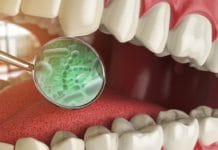Did you know that the mouth is a window to overall health? Think about that for a second. The anatomical area treated with our expertise is also where many health conditions and diseases begin. By thoroughly examining and paying particular attention to our patients, we can be an intervention when needed. Dental professionals possess the ability to guide patients to better overall health. Signs and symptoms that are typically overlooked by other medical professionals can be the doorway in helping to diagnose a health-related issue.
When a patient enters the dental office, one of the first things I do after greeting them is to inquire about their health and ask about any oral health issues. In itself, this verbal update can bring about potential concerns for further discussion. Paying attention to patient concerns and probing for more information is essential to complete treatment. The more a patient reveals, the more we can narrow down probable causes.
A Casual Exam
After radiographs are taken (if needed), I also do a physical assessment of my patient. I try to do this as inconspicuously as possible, often during the small talk, while prepping the patient for treatment. Lesions on the face and neck are noted, and if the area seems concerning, I make sure to bring these areas to the patient’s attention. Skin malignancies are the most common cancer in the United States and often present as abnormal growths on the skin such as waxy, crusty, mole-like lesions.1 This is also a great time to palpate lymph nodes if time allows. If the area needs further assessment, I encourage medical consultation. Enlarged lymph nodes can be attributed to many concerns such as infection, immune disorders, and cancer.2 Always advise a follow-up with their primary care provider.
During my oral examination, I pay close attention to the dentition for cracks or attrition. This can indicate signs of whether the patient is experiencing bruxism related to stress or chewing hard natured items such as ice. The practice of chewing items that have no nutritional value is called pica.3 Chewing ice (pagophagia) is a very undesirable yet common habit but if the patient has a compulsive desire to chew ice. This can be a sign of an iron deficiency with or without anemia.3
By inquiring about these areas with the patient, it can uncover the need for any medical intervention.
Oral Pathology
After the oral dentition has been evaluated, I then perform an oral pathology screening. Outside of the most obvious reason for this exam, cancer, I also look and feel for any abnormalities. For example, a fissured tongue can be an indication of a biotin deficiency; biotin belongs to the vitamin B family.
Sjogren’s syndrome has many oral manifestations that can be clinically seen. One of the most common symptoms is xerostomia. In fact, research suggests that 88% of Sjogren’s syndrome subjects exhibited reduced salivary flow followed with complaints of xerostomia up to 92%.4 Other symptoms include erythematous or dry laden coarse tongue, angular cheilitis, cracked/peeling lips, mucositis, and ulcers.
Although rare, another condition known as Melkersson-Rosenthal syndrome is accompanied by a fissured tongue. This neurological disorder is additionally characterized by facial paralysis and swollen/cracked lips.4
Thoroughly examining the tonsillar region also proves to be vital. Again, cancer can be found in this region, but irritated tonsils are also an indication of other illnesses. Obstructive sleep apnea (OSA) is often accompanied by large tonsillar regions due to snoring, especially in children.5 Because OSA can be fatal, it is important to discuss the possibility of this with patients.
Beyond the physical and visual assessments, we are given a view that many are not afforded – routine radiographs. Radiographs give us an inside look and can reveal areas of concern outside of dentistry.
Panoramic x-rays specifically include the surrounding structures of the head and neck and therefore can reveal potential health alarms. Cysts, tumors, and carotid artery calcification (CAC) are among the conclusions that can be found on a panoramic x-ray. In fact, one study conducted using 200 females over the age of 50 found that 11% had CAC visible on their panoramic x-ray.4
Dental professionals alone cannot be held completely liable in the medical diagnosing of patients. However, it is important that we take the necessary steps to assist and educate our patients in areas of concern. By thinking “outside of the box” and training ourselves to look for issues beyond dental concerns, we can potentially save a life.
Before you leave, check out the Today’s RDH self-study CE courses. All courses are peer-reviewed and non-sponsored to focus solely on high-quality education. Click here now.
Listen to the Today’s RDH Dental Hygiene Podcast Below:
References
- “Skin Cancer of the Head and Neck.” Edited by Dr. Christine Gourin, Johns Hopkins Medicine, https://www.hopkinsmedicine.org/health/conditions-and-diseases/skin-cancer-of-the-head-and-neck.
- “Swollen Lymph Nodes.” Mayo Clinic, Mayo Foundation for Medical Education and Research, 9 Oct. 2019, https://www.mayoclinic.org/diseases-conditions/swollen-lymph-nodes/diagnosis-treatment/drc-20353906.
- Craving and Chewing Ice: A Sign of Anemia? Mayo Clinic, Mayo Foundation for Medical Education and Research. 9 Mar 2018. Retrieved from https://www.mayoclinic.org/diseases-conditions/iron-deficiency-anemia/expert-answers/chewing-ice/faq-20057982
- Sjögren’s Syndrome: Oral Manifestations and Treatment, a Dental Perspective, Deborah L. Cartee, Shannon Maker, Debra Dalonges, Marion C. Manski, American Dental Hygienists’ Association Dec 2015, 89 (6) 365-371
- “Children and Sleep Apnea.” Sleepapneaorg, American Sleep Apnea Association , 2019, www.sleepapnea.org/children-and-sleep-apnea/.
- Melkersson-Rosenthal Syndrome Information Page. National Institute of Neurological Disorders and Stroke. U.S. Department of Health and Human Services. Retrieved from https://www.ninds.nih.gov/Disorders/All-Disorders/Melkersson-Rosenthal-Syndrome-Information-Page
- Moshfeghi, M., et al. Relationship between carotid artery calcification detected in dental panoramic images and hypertension and myocardial infarction. Iranian Journal of Radiology. 2014; 11(3): e8714. doi:10.5812/iranjradiol.8714.












